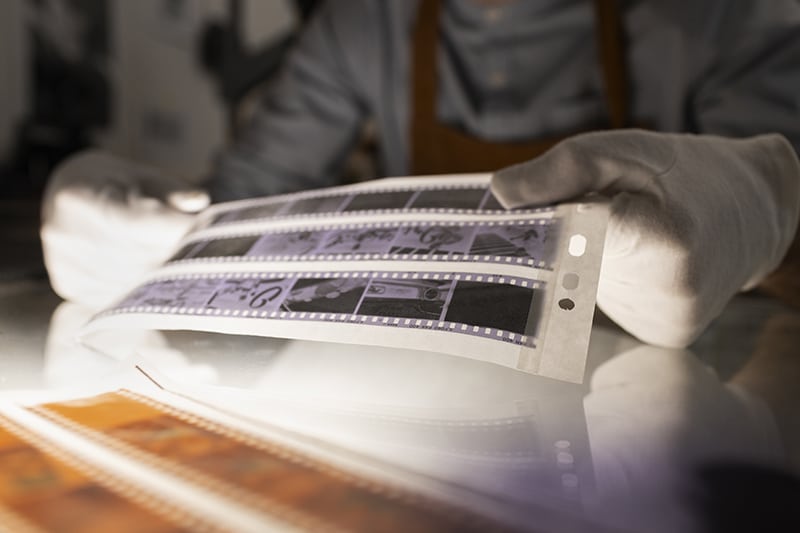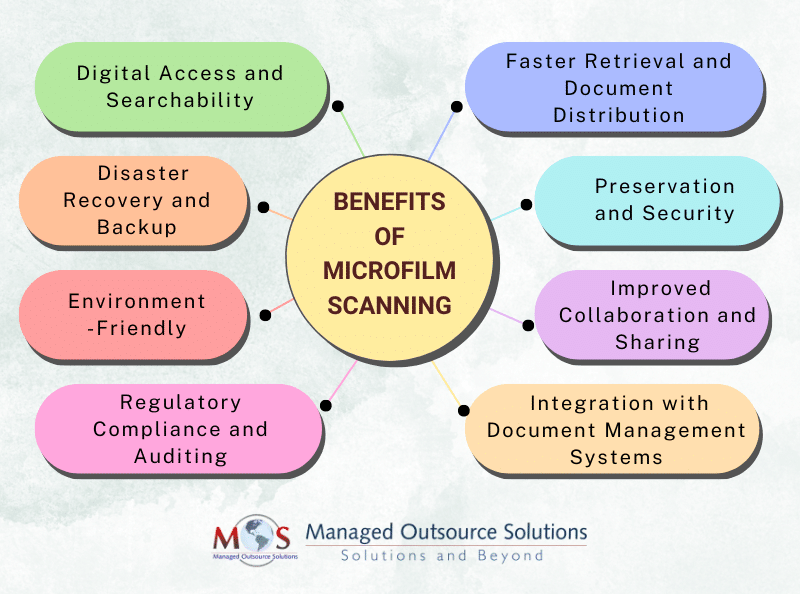Many businesses organizations still have valuable data stored in microfilms and microfiche. Poor storage can cause deterioration of microfilm and loss of valuable data. Microfilm scanning services can provide the solution.
Scanning microfilms helps in preserving and accessing valuable information, contributing significantly to the archival and historical preservation efforts of various institutions. It enables institutions such as libraries, government agencies, and businesses to efficiently manage and share historical documents, newspapers, manuscripts, and other critical records. By embracing microfilm scanning, organizations get to enhance their ability to protect cultural heritage, facilitate research, and streamline information retrieval processes, ultimately contributing to the preservation and dissemination of knowledge for future generations.
Benefits of Microfilm Digitization
Microfilm rolls are not easily accessible; neither can these be shared among multiple users. In addition, you need microfilm readers to search for data on these rolls. If this equipment is damaged or unavailable, access to the information becomes virtually impossible. The benefits of converting microfilm to digital images include:
- Digital documents can be swiftly searched for specific information by indexing, tagging, and searching them. Information can be searched and retrieved in seconds without having to use any specialized equipment.
- Digital documents can be preserved and also backed up and encrypted for increased security.
- Multiple users can access the images simultaneously over a network.
- Data availability is improved, helping to meet audit and compliance requirements.
- The images created can be printed, e-mailed or faxed.
From historical societies and libraries to churches, many institutions have launched or completed microfilm digitization projects. In 2022, the Arkansas State Archives digitized over 240,000 pages of historic newspapers for the Chronicling America project. The project’s goal is to digitize 100,000 to 110,000 pages in each two-year cycle, said Katie Adkins, archivist for the Arkansas Digital Newspaper Project (www.arkansasonline.com).
In 2021, The Church of Jesus Christ of Latter-day Saints completed the digitization of 2.4 million rolls of microfilm.” These family history records are now available to anyone who has a computer, anyone who has an Internet connection, and you can find documents and records now anywhere in the world that relate to your family,” explained Kris Whitehead, a manager for FamilySearch International, based in Salt Lake City (churchofjesuschrist.org).
Want to learn more?
Read our blog post:
Microfilm Digitization and Conversion: Process and Purpose
Libraries, historical societies, educational institutions and various research settings invest in advanced digital microfilm readers/printers/scanners to create high-resolution images from microfilm and store them in an external storage device in the required electronic format – TIFF, JPEG, searchable PDF and so on. Advanced scanners, such as those used by document conversion companies, have exciting features such as automatic film scanning, optical rotation, auto scan positioning, automatic focusing, spot editing and the ability to clip articles in various shapes.
Microfilm digitization can be a challenging process. Moreover, many organizations often face budgetary constraints or limited resources to undertake comprehensive digitization projects which require investments in specialized equipment, skilled personnel, and storage infrastructure for digital files.
Challenges of Microfilm Digitization
While it offers numerous benefits, there are several challenges associated with microfilm digitization. That’s why it’s important that the process be handled by digitization experts.
Some of the key challenges include:
Fragility and degradation
Microfilm reels and sheets are prone to physical damage, deterioration, and degradation over time. Microfilm for digitization should be handled and prepared without causing further damage, which can be challenging. It is important to find out whether the microfilm or microfiche is too damaged for scanning. Here are some of the important considerations:
- Acetate-based microfilms can be damaged if they are exposed to humidity and fluctuating temperatures. In such cases, the microfilms will produce a vinegar-like smell and therefore it is known as vinegar syndrome. The microfilms can become brittle and break; they may also start sticking together. If there is serious deterioration, a microfilm scanning project may not be feasible.
- High humidity and high temperatures can speed up chemical processes and the subsequent deterioration. Fungus growth can also be accelerated by these conditions. Fungus attacks cannot be reversed and in this case, there is no point in scanning the records.
This highlights the importance of ensuring safe storage of your microfilms.
Varying film formats
Microfilm comes in different formats, such as roll film, aperture cards, and microfiche, with varying sizes, image densities, and aspect ratios. Each format requires specific equipment and techniques for digitization, making the process more complex and time-consuming.
Metadata and indexing
Microfilm collections often lack comprehensive metadata or indexing, making it challenging to search and retrieve specific records efficiently. Digitization projects need to address the task of creating accurate and detailed metadata to enable effective searching and browsing of the digital collection.
Large-scale digitization
Microfilm collections can be vast and extensive, containing millions of images. Digitizing such large-scale collections within limited timeframes and resources can be a significant challenge, requiring careful planning, allocation of resources, and scalability.
Quality control and accuracy
Ensuring the accuracy and completeness of the digitized images and associated metadata is crucial. Quality control measures, such as image verification, data validation, and error correction, need to be implemented to maintain the integrity and reliability of the digitized collection.
Long-term preservation
While digitizing microfilm improves accessibility, it also raises concerns about the long-term preservation of the digital files. Technological obsolescence, file format compatibility, and data migration strategies need to be considered to ensure the continued accessibility and usability of the digitized collection over time.
Leverage Expertise for Successful Digitization
Before embarking on a digitization project, have a professional organization examine your microfilm archive to determine the feasibility of digitization. It may be possible to recover some microfilms; however, these need to be handled very carefully to avoid further damage. Specialized equipment and technical expertise are necessary for capturing clear and legible digital images from microfilm.
Addressing the challenges of microfilm digitization requires careful planning, investment in appropriate equipment and expertise, and adherence to established digitization standards and best practices. Preservation experts, librarians, and archivists are increasingly collaborating with digitization specialists to overcome these challenges and ensure successful microfilm digitization.
Large-scale digitization can be handled affordably by experienced microfilm scanning services. Leveraging outsourced support can ensure smooth and efficient conversion without the need for huge investments. Experts can ensure that images from the microfilm are captured utilizing advanced technologies, efficient procedures, meticulous planning, and attention to detail. When choosing a business process outsourcing company, make sure to consider factors such as accuracy of scanning, digital image quality, and pricing.
Transform your archives with our microfilm scanning services.
Enjoy enhanced accessibility, improved data preservation, and streamlined information retrieval
Get started today!





